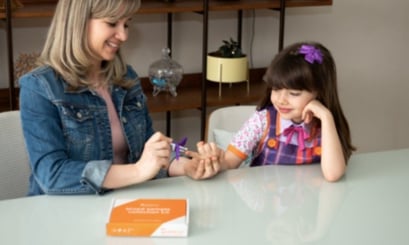Share this
pediatric research can be done remotely
by Neoteryx Microsampling on Jan 10, 2022 9:00:00 AM
Research scientists and clinical trial managers can take advantage of the technologies that doctors are using in telemedicine to access patients at home. Shipping remote specimen collection kits out to study subjects at home, and connecting with them through telephone calls, video chats, digital enrollment portals, and online updates, will help your remote studies and virtual trials succeed.
 The remote approach can work particularly well for pediatric studies, where parents prefer the convenience of enrolling their children in research that allows them to stay safe at home as much as possible.
The remote approach can work particularly well for pediatric studies, where parents prefer the convenience of enrolling their children in research that allows them to stay safe at home as much as possible.
The Pandemic Proved That Remote Studies Work
The COVID-19 Pandemic and associated lockdowns forced the science and medical communities to pivot to remote research models. Thanks to the Internet and other technologies available today, this remote approach was largely successful. Instead of asking their patients and study subjects to travel to and from the clinic or trial site for their lab tests and follow-up appointments, providers sent the “lab” to them.
Practitioners monitoring post-transplant kids collected the necessary blood samples from them by mailing specimen collection kits out to their homes. Family members used the provided instructions & video demos to assist their children in collecting their own specimen samples. Once collected, samples were safely sealed into specimen bags and special envelopes for mailing to the designated lab for analysis. This remote approach produced reliable data that researchers and practitioners used to make critical decisions. Referencing that data, providers also conducted follow-up appointments via video, email and phone.
 How Technology & Remote Specimen Collection Apply to Pediatric Studies
How Technology & Remote Specimen Collection Apply to Pediatric Studies
Researchers and physicians working with pediatric populations across great distances can use an array of remote technologies to share documents and communicate in real time with colleagues, study participants or patients, while also accessing important data. Now doctors in Mozambique can reach out to their colleagues in Chicago and discuss cases. Telehealth technologies, when paired with remote specimen collection, allow them to monitor individuals, discuss lab and serology reports, adjust dosing in medication, and more. They can evaluate sick children at a remote school or a distant clinic or gather specimen samples at a field site in an underdeveloped country.
In conjunction with increasingly sophisticated telemedicine approaches, remote pediatric blood collection is helping to make research and healthcare available to more people around the globe. Microsampling technology that is based on dried specimen collection versus liquid sample collection is easier in remote areas because no refrigeration or freezer transport and storage are necessary.
For example, very small samples of blood can be collected from a quick and easy fingerstick using a portable Mitra® device. A precise volume of blood is rapidly absorbed on the device’s VAMS® tip. This sample will dry on the tip during shipment via regular post. Unlike the sample contamination risks posed by dried blood spot (DBS) cards during shipment, Mitra microsamples are protected within the device’s plastic outer cartridge.
With portable and easy-to-use Mitra devices, no professional phlebotomist is required to conduct a venipuncture blood draw to collect wet blood samples in tubes. By following simple instructions, research personnel or study subjects can easily collect Mitra samples at home or in low-resource locations for low-cost mailing to a central lab.
The fingerstick microsampling technique is also much less stressful for children, especially if it can be performed in the comfort of home or other familiar surroundings with a parent or other family member to help.
Remote technologies and remote specimen collection using dried samples can be applied in many situations and environments:
- Management of chronic medical and medical problems. After an initial in-clinic evaluation and training/orientation on how to perform fingerstick sampling, study subjects or patients can self-collect samples at home and use telemedicine technology to follow-up with their research trial coordinator or doctor.
- Peer-to-peer consultations. The attending physician can confer with research experts and medical peers around the world for help with cases or special public health programs.
- Education. Researchers, lab technicians and doctors can attend webinars virtually without the expense of travel, to learn how to apply remote sampling & remote monitoring using the latest technologies.
- Therapeutic drug monitoring / patient monitoring. The physician can "see" his or her patients at times when they are unable to come to hospital or the clinic office. Specimen samples can be mailed directly from home to lab, where samples are analyzed, and bloodwork data can be uploaded online for access by the physician or clinical trial manager.
- Research. Remote technologies have had a positive impact on medical research, helping to minimize disruptions to important studies caused by geographical distances or lockdowns during pandemics. Specimen collection kits can be shipped out to people at home, and research subjects can be reached a city or county away from the research center, greatly increasing the number and diversity of people available for studies.
- Personalized medicine, self-care & compliance. Remote technologies put patients, study subjects and their families in control, giving them more agency in managing their care. Research subjects often express a preference for self-collecting their own specimen samples at home and mailing them to the lab, rather than visiting the study site. The comfort and convenience of at-home specimen collection and telehealth communications with the staff also eliminates the need for taking time away from work or school for a day of travel. Since remote studies require less time commitment, more people are likely to enroll in studies they might otherwise skip. Professional personnel and parents report that children are less anxious or fearful of fingerstick microsampling at home, which is a much gentler approach compared to the traditional needle-poke in the arm vein for a blood draw at the lab or clinic.

Share this
- Microsampling (206)
- Research, Remote Research (119)
- Venipuncture Alternative (105)
- Clinical Trials, Clinical Research (83)
- Mitra® Device (73)
- Therapeutic Drug Monitoring, TDM (51)
- Dried Blood Spot, DBS (39)
- Biomonitoring, Health, Wellness (30)
- Infectious Disease, Vaccines, COVID-19 (24)
- Blood Microsampling, Serology (23)
- Omics, Multi-Omics (21)
- Decentralized Clinical Trial (DCT) (20)
- Specimen Collection (18)
- Toxicology, Doping, Drug/Alcohol Monitoring, PEth (17)
- Skin Microsampling, Microbiopsy (14)
- hemaPEN® Device (13)
- Preclinical Research, Animal Studies (12)
- Pharmaceuticals, Drug Development (9)
- Harpera Device (7)
- Industry News, Microsampling News (5)
- Antibodies, MAbs (3)
- Company Press Release, Product Press Release (3)
- Environmental Toxins, Exposures (1)
- July 2025 (1)
- May 2025 (1)
- April 2025 (2)
- December 2024 (2)
- November 2024 (1)
- October 2024 (3)
- September 2024 (1)
- June 2024 (1)
- May 2024 (1)
- April 2024 (4)
- March 2024 (1)
- February 2024 (2)
- January 2024 (4)
- December 2023 (3)
- November 2023 (3)
- October 2023 (3)
- September 2023 (3)
- July 2023 (3)
- June 2023 (2)
- April 2023 (2)
- March 2023 (2)
- February 2023 (2)
- January 2023 (3)
- December 2022 (2)
- November 2022 (3)
- October 2022 (4)
- September 2022 (3)
- August 2022 (5)
- July 2022 (2)
- June 2022 (2)
- May 2022 (4)
- April 2022 (3)
- March 2022 (3)
- February 2022 (4)
- January 2022 (5)
- December 2021 (3)
- November 2021 (5)
- October 2021 (3)
- September 2021 (3)
- August 2021 (4)
- July 2021 (4)
- June 2021 (4)
- May 2021 (4)
- April 2021 (3)
- March 2021 (5)
- February 2021 (4)
- January 2021 (4)
- December 2020 (3)
- November 2020 (5)
- October 2020 (4)
- September 2020 (3)
- August 2020 (3)
- July 2020 (6)
- June 2020 (4)
- May 2020 (4)
- April 2020 (3)
- March 2020 (6)
- February 2020 (3)
- January 2020 (4)
- December 2019 (5)
- November 2019 (4)
- October 2019 (2)
- September 2019 (4)
- August 2019 (4)
- July 2019 (3)
- June 2019 (7)
- May 2019 (6)
- April 2019 (5)
- March 2019 (6)
- February 2019 (5)
- January 2019 (8)
- December 2018 (3)
- November 2018 (4)
- October 2018 (7)
- September 2018 (6)
- August 2018 (5)
- July 2018 (8)
- June 2018 (6)
- May 2018 (5)
- April 2018 (6)
- March 2018 (4)
- February 2018 (6)
- January 2018 (4)
- December 2017 (2)
- November 2017 (3)
- October 2017 (2)
- September 2017 (4)
- August 2017 (2)
- July 2017 (4)
- June 2017 (5)
- May 2017 (6)
- April 2017 (6)
- March 2017 (5)
- February 2017 (4)
- January 2017 (1)
- July 2016 (3)
- May 2016 (1)
- April 2016 (2)


No Comments Yet
Let us know what you think